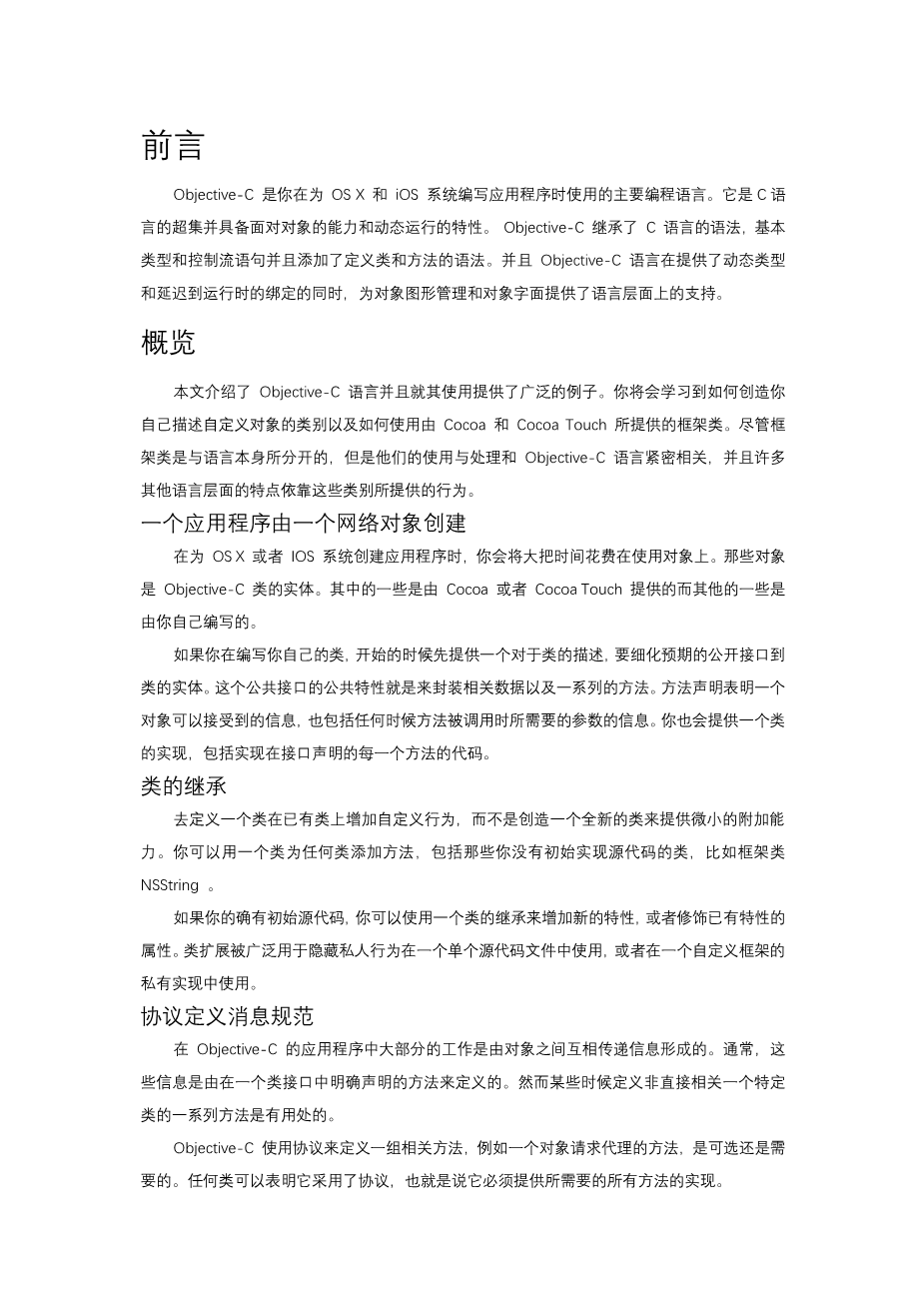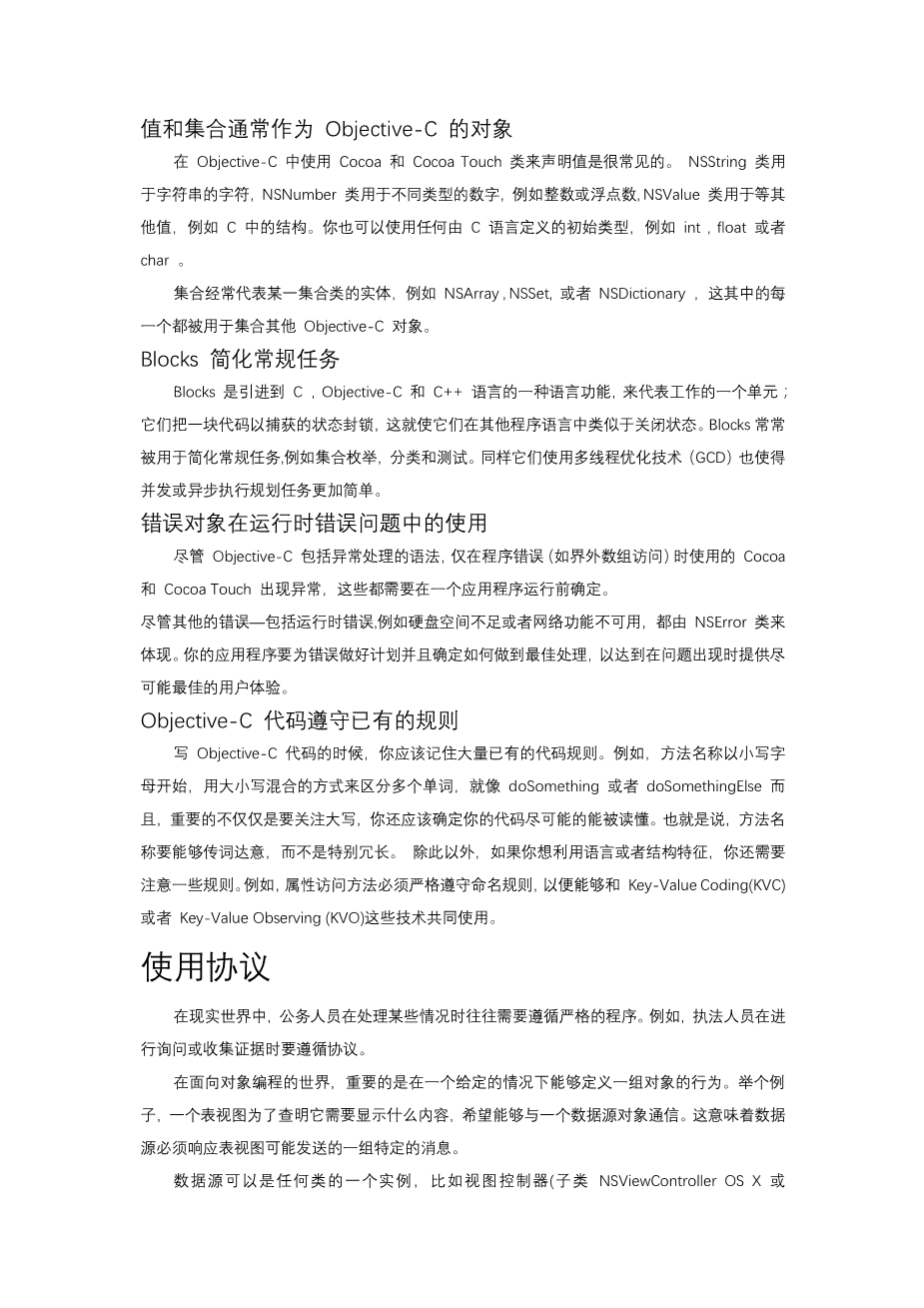About Objective-C
Objective-C is the primary programming language you use when writing software for OS X and iOS. Itrsquo;s a superset of the C programming language and provides object-oriented capabilities and a dynamic runtime. Objective-C inherits the syntax, primitive types, and flow control statements of C and adds syntax for defining classes and methods. It also adds language-level support for object graph management and object literals while providing dynamic typing and binding, deferring many responsibilities until runtime.
At a Glance
This document introduces the Objective-C language and offers extensive examples of its use. Yoursquo;ll learn how to create your own classes describing custom objects and see how to work with some of the framework classes provided by Cocoa and Cocoa Touch. Although the framework classes are separate from the language, their use is tightly wound into coding with Objective-C and many language-level features rely on behavior offered by these classes.
An App Is Built from a Network of Objects
When building apps for OS X or iOS, yoursquo;ll spend most of your time working with objects. Those objects are instances of Objective-C classes, some of which are provided for you by Cocoa or Cocoa Touch and some of which yoursquo;ll write yourself.
If yoursquo;re writing your own class, start by providing a description of the class that details the intended public interface to instances of the class. This interface includes the public properties to encapsulate relevant data, along with a list of methods. Method declarations indicate the messages that an object can receive, and include information about the parameters required whenever the method is called. Yoursquo;ll also provide a class implementation, which includes the executable code for each method declared in the interface.
Categories Extend Existing Classes
Rather than creating an entirely new class to provide minor additional capabilities over an existing class, itrsquo;s possible to define a category to add custom behavior to an existing class. You can use a category to add methods to any class, including classes for which you donrsquo;t have the original implementation source code, such as framework classes like NSString.
If you do have the original source code for a class, you can use a class extension to add new properties, or modify the attributes of existing properties. Class extensions are commonly used to hide private behavior for use either within a single source code file, or within the private implementation of a custom framework.
Protocols Define Messaging Contracts
The majority of work in an Objective-C app occurs as a result of objects sending messages to each other. Often, these messages are defined by the methods declared explicitly in a class interface. Sometimes, however, it is useful to be able to define a set of related methods that arenrsquo;t tied directly to a specific class.
Objective-C uses protocols to define a group of related methods, such as the methods an object might call on its delegate, which are either optional or required. Any class can indicate that it adopts a protocol, which means that it must also provide implementations for all of the required methods in the protocol.
Values and Collections Are Often Represented as Objective-C Objects
Itrsquo;s common in Objective-C to use Cocoa or Cocoa Touch classes to represent values. The NSString class is used for strings of characters, the NSNumber class for different types of numbers such as integer or floating point, and the NSValue class for other values such as C structures. You can also use any of the primitive types defined by the C language, such as int, float or char.
Collections are usually represented as instances of one of the collection classes, such as NSArray, NSSet, or NSDictionary, which are each used to collect other Objective-C objects.
Blocks Simplify Common Tasks
Blocks are a language feature introduced to C, Objective-C and C to represent a unit of work; they encapsulate a block of code along with captured state, which makes them similar to closures in other programming languages. Blocks are often used to simplify common tasks such as collection enumeration, sorting and testing. They also make it easy to schedule tasks for concurrent or asynchronous execution using technologies like Grand Central Dispatch (GCD).
Error Objects Are Used for Runtime Problems
Although Objective-C includes syntax for exception handling, Cocoa and Cocoa Touch use exceptions only for programming errors (such as out of bounds array access), which should be fixed before an app is shipped.
All other errors—including runtime problems such as running out of disk space or not being able to access a web service—are represented by instances of the NSError class. Your app should plan for errors and decide how best to handle them in order to present the best possible user experience when something goes wrong.
Objective-C Code Follows Established Conventions
When writing Objective-C code, you should keep in mind a number of established coding conventions. Method names, for example, start with a lowercase letter and use camel case for multiple words; for example, doSomething or doSomethingElse. Itrsquo;s
全文共38867字,剩余内容已隐藏,支付完成后下载完整资料


英语原文共 16 页,剩余内容已隐藏,支付完成后下载完整资料
资料编号:[228],资料为PDF文档或Word文档,PDF文档可免费转换为Word


